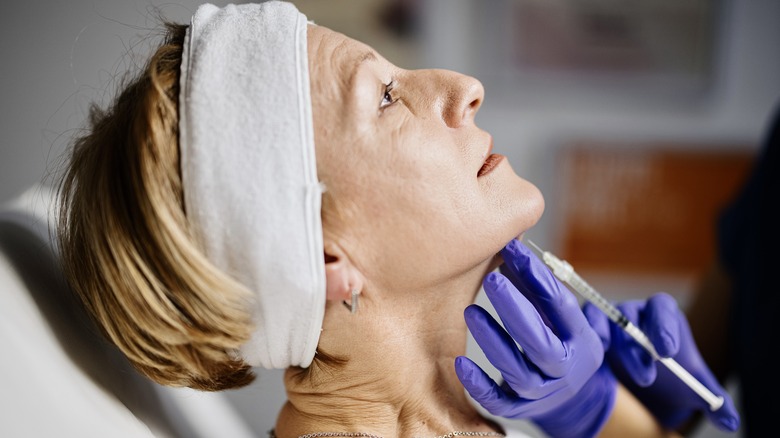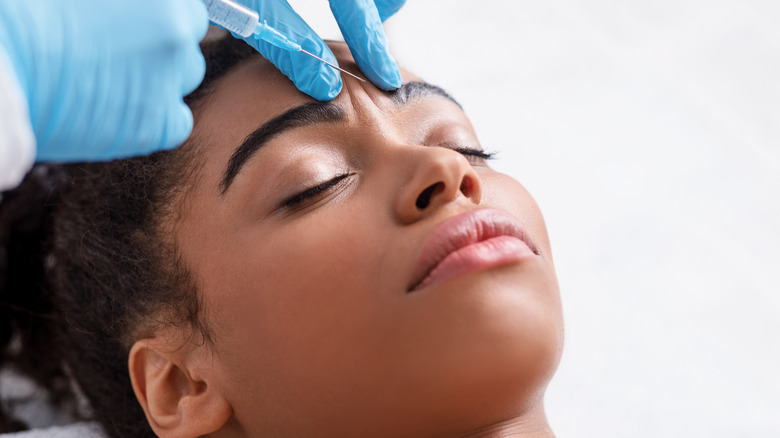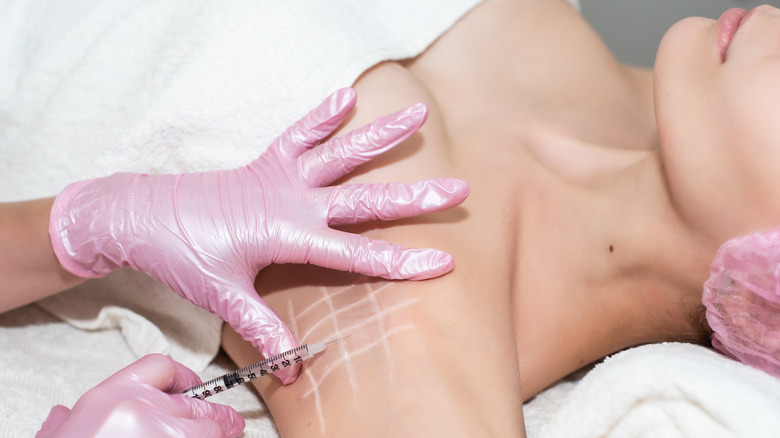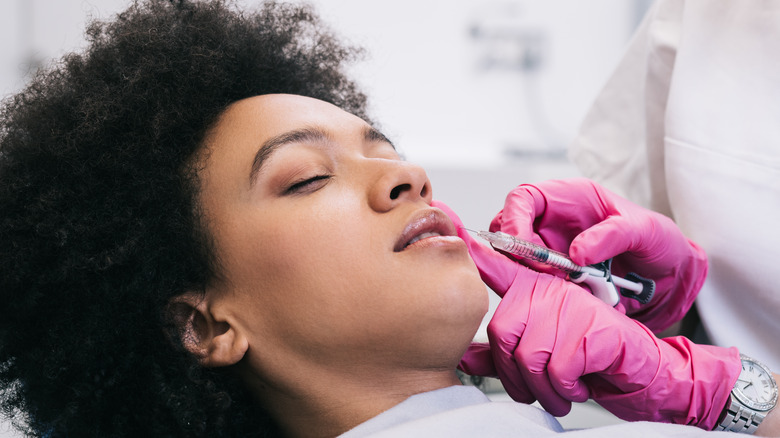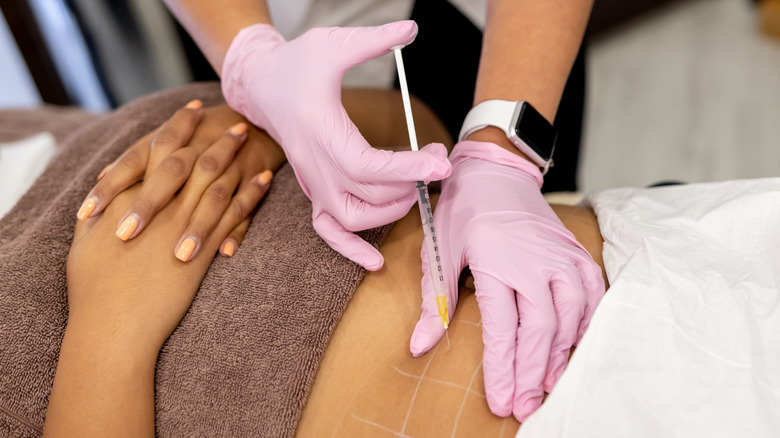4 Health Benefits Of Botox, Because It's Not All Just About Vanity
When we think about Botox, the first thing that usually comes to mind is the impact a few injections have on the face. Crow's feet, forehead wrinkles, and those pesky 11s between your eyebrows, as they're called, can easily be minimized, if not completely wiped out by Botox. For those looking for the fountain of youth but aren't ready to go under the knife for invasive procedures like a full facelift, Botox is the next best thing.
Typically, we equate Botox with vanity, and there's nothing wrong with that because it's your body, and you should do whatever will help you feel most confident. But Botox actually has other benefits. Health benefits that, for some, can really transform their lives, making the day-to-day easier to handle.
To give a bit of background, Botox is made from a toxin that causes botulism, a rare form of food poisoning that, when purified, prevents muscles from moving via shots that should only be administered by an expert, per Medline Plus. Because it prevents muscles from moving, Botox offers more than just appearing 10 years younger than you actually are. In fact, as much as wiping away a bunch of wrinkles can help with self-esteem, the results of the health benefits that come with it — like relief from migraines and excessive sweating — may be even greater.
It can minimize migraines
People who suffer from migraines know just how debilitating they can be. Depending on the intensity and length of the migraine, it can actually cause some people to be in bed for a few days, with the shades drawn, as they wait for the migraine to pass. Because over-the-counter medications like ibuprofen don't always work for more severe cases, people who struggle with regular migraines often have prescriptions that help aid in reducing pain. But even these medications don't always completely alleviate migraines and the side effects that come with them. However, Botox does.
When the FDA approved Botox as a treatment for chronic migraines in 2010, Dr. Scott M. Whitcup told The New York Times, "For the business, Botox has been an incredible medication. We call it our pipeline in a vial... People still think about it as a cosmetic product, but the therapeutic indications in the next five years will far surpass its cosmetic use."
According to the American Migraine Foundation, chronic migraines are those that appear at least 15 days a month. When people get Botox for migraines, they receive several injections in the head and neck area. These treatments are intended to prevent migraines from occurring in the first place, and each treatment lasts about three months. Because it's not cosmetic and if your doctor can prove your chronic migraine status, some insurance plans will cover treatments.
It can reduce sweating
Although sweating is completely natural and serves the very important function of maintaining body temperature, some people are super sweaters, or sweat when they really don't want to (like a big, important meeting), or are those types who have persistently clammy, damp hands. That's where Botox comes in to help these folks.
The way Botox works when it comes to minimizing sweating in a person is that it's injected in the affected area to block acetylcholine, a neurotransmitter that sends signals to the sweat glands that it's time to sweat, via Healthline. For those who suffer from hyperhidrosis, which is excessive, uncontrollable sweating, Botox steps in to paralyze the nerves so those signals stay blocked. According to a 2021 study published in the Journal of Drug Assessment, Botox treatment for sweating had a 90% efficacy rate and the decrease in sweat was noticeable within two weeks of the initial treatment.
However, it's not exactly cheap. It can cost as much as $1000 for both armpits, but you may not need to worry about another round of treatment for close to a year and a half, so that's sort of a bonus. Also, because Botox is only FDA-approved for armpits, other places where you may want to stop your excessive sweating may not be covered by insurance.
It can cease teeth grinding and jaw clenching
For people who grind their teeth at night or clench their jaw when they're awake, Botox can be a saving grace because it relaxes the masseter. The masseter muscle runs along the lower jaw and part of the cheek, so when it's injected with Botox, jaw-related stress is basically put at peace.
"More patients than ever are complaining of jaw pain, TMJ, and headaches," cosmetic dermatologist Laura Dyer, PA-C told The Zoe Report. "I think the past two years have been very stressful on most people, and many of them are carrying the stress in their masseter muscles and have a tense overall lower face... Some people [use] Botox [in] this area to help decrease jaw clenching, the relaxation of this muscle can help with TMJ, teeth grinding, and headaches."
According to the Mayo Clinic, bruxism (teeth grinding) can cause not only tooth damage like fractures, but can also result in headaches, disorders like sleep apnea, and overall restless nights.
It can prevent incontinence
One of the lesser-known health benefits of Botox is its effect on incontinence. According to a 2011 study published in the Journal of Urology, for those 20 years of age and older, 51.1% of people with vulvas and 13.9% of people with penises deal with urinary incontinence. With age, these percentages increase. Being unable to hold your urine, or accidentally peeing yourself when you laugh or sneeze, isn't just uncomfortable, but can be embarrassing. While there are adult diapers, if you can avoid having to wear diapers for the rest of your life, wouldn't you?
Similar to how Botox stops sweating and migraines, it's all about blocking the nerve signals that stop involuntary urination, leakage, and even the urge to pee. According to Advanced Gynecology, this outpatient procedure in which only local anesthetic is used to numb the bladder, is performed by Botox actually being injected into the bladder muscles. It can take anywhere from two to 12 weeks for patients to experience the full results of the procedure and the Botox will block the nerve signals for up to six months before it's time for another round. Because it's a Botox-related medical treatment, some insurance plans will cover it.
When Botox first hit the market, little did the world know that with more research, its health benefits would outweigh the vanity benefits. Yet, here we are. Now you can pop into a clinic, and get your 11s erased and jaw relaxed all at once.
